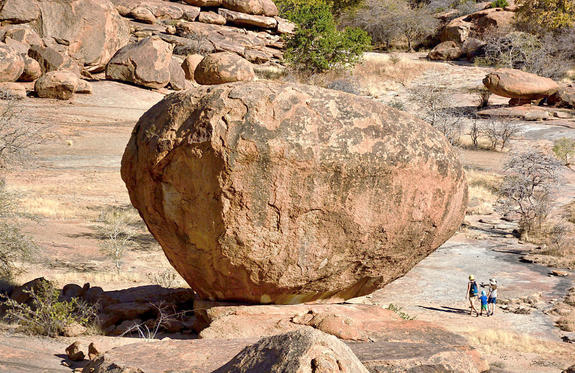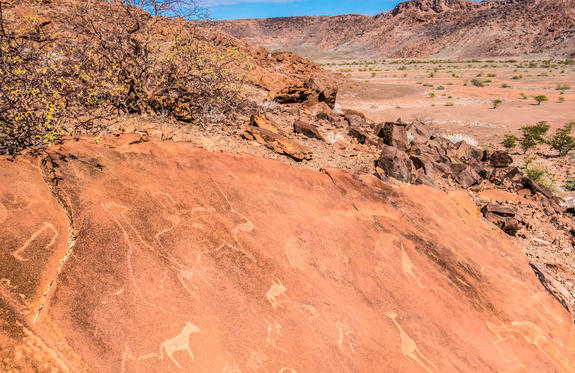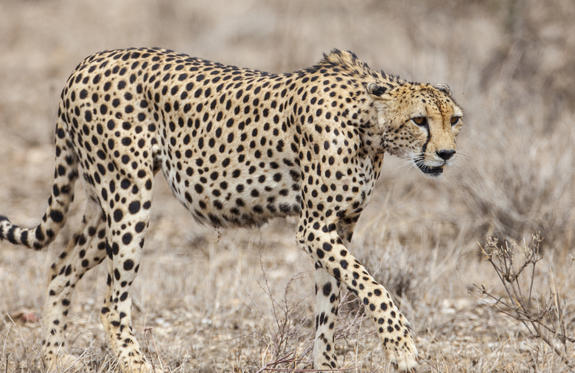Located in southwestern Africa, Namibia boasts a well-developed infrastructure, some of the best tourist facilities in Africa, and an impressive list of breathtaking natural wonders. Visitors can explore the capital of Windhoek and discover the lovely coastal town of Swakopmund boasting remnants of the country’s German influence, reflected in the architecture, culture, cuisine and the annual Oktoberfest celebrations. To properly appreciate this extraordinary country, you will have to venture out of the cities to explore the remarkable natural landscapes Namibia has to offer. These include: the impressive Fish River Canyon; the vast Etosha National Park teeming with abundant wildlife, such as lions, desert-adapted elephants and the Hartmann's Mountain Zebra; the hauntingly beautiful Kalahari Desert; and of course the Namib Desert stretching for over 2000 km along the magnificent Atlantic Coast. Namibia is an ideal destination for travellers seeking an unforgettable African experience in a uniquely beautiful untamed wilderness.

Situated in Central Namibia, the cosmopolitan city of Windhoek serves as the capital of the country. It is home to an international airport and a plethora of restaurants, shops, entertainment venues and accommodation options. The city is clean, safe and well-organised, with a colonial legacy that is reflected in its many German eateries and shops, and the widespread use of the German language. Windhoek has an interesting mix of historical architecture and modern buildings, many of which are worth a look, including the Alte Feste an old fort, the 1896 Christuskirche Christ Church, and the more contemporary Supreme Court.

Set just 250 kilometres from the bustling capital of Namibia, the 10,000-hectare Intu Afrika Kalahari Game Reserve presents a landscape of unparalleled natural splendour. Deep red and clay-coloured dunes fan into the distance, decorated with areas of grasslands, shrubs, and trees. The park is home to an impressive array of wildlife, including black wildebeest, springbok, oryx, giraffe, and a large population of meerkats. This is the perfect place to learn about the ancient way of life; visitors can follow a !Kung guide through the desert and learn survival techniques. Make sure to take a look at the exquisite handmade crafts in the village. Hiking, 4x4 excursions, and quad-biking will appeal to adrenaline seekers.

Carving out an epic rocky wonderland in southern Namibia, the Fish River has created Africa’s largest, and the world’s second-largest, canyon. Hot, dry and dramatic, the Fish River Canyon stretches for an astonishing 160 kilometres, reaching up to 27 kilometres wide and 550 metres deep. Its vast, rugged beauty draws visitors from across the globe. Adventurers can tackle the challenging 85 kilometre Fish River Hiking Trail, which winds through 1.5 billion years of geological history, while those seeking rest can soak in the mineral-rich hot springs of Ai-Ais or admire breathtaking views from Hobas Restcamp and other viewpoints along the rim. Scenic chartered flights, horse riding, nature drives, and seasonal kayaking complete this unforgettable Namibian experience.

Sandwiched between the rugged and stark Atlantic Coast and the arid desert of Namibia, the town of Luderitz is located in an incredible unique geographical setting. This seaside town is something of an anomaly frozen in time – a piece of 19th-century Bavaria bordering the pinkish sand dunes of the Namib Desert. Lutheran churches, German bakeries, and colonial buildings boasting German art nouveau architecture are dotted about the settlement, while its windswept beaches are home to flamingos, ostriches, seals, and penguins. The nearby ghost town of Kolmanskop, which has been taken over by the desert dunes, is another fascinating must-see attraction, located approximately 10 kilometres from Luderitz central, along with the herd of wild desert-adapted horses near the small town of Aus.

Isolated on private land a the edge of the Namib Desert, the tiny village of Helmeringhausen was founded during the German colonial era. Here, one can enjoy an atmosphere of peace and tranquillity that only the wilderness can provide. The town serves as an idyllic and convenient base for exploring the breathtaking Fish River Canyon, the largest in Africa, with its technicolour scenes and refreshing turquoise pool; nearby Luderitz, with its mysterious ghost town and stunning coast; the astonishing landscapes of Sossusvlei; and the enthralling Naukluft National Park.

As there is no accommodation at Sossusvlei, visitors to this desert wilderness are likely to end up staying at Sesriem, 65 kilometres away, where camps and lodges serve as a base from which to explore the dunes. Sesriem Canyon, a deep chasm carved through the rocks by water, is a striking natural feature of the area that is best explored on foot. Stony walls rise up sharply on both sides of the canyon, while birds roost in its crags and lizards dart along the ledges. The canyon’s name was coined when early settlers used it as a water source, using six lengths of leather (‘ses riem – six thongs) tied together to lower buckets into the water at the base of canyon.)

Set along Namibia's spectacularly scenic coast, the seaside town of Swakopmund is known for its wide-open avenues, colonial architecture, and its surrounding otherworldly desert terrain. Founded in 1892 as the main harbour for German South-West Africa, Swakopmund is often described as being more German than Germany. Now a seaside resort town, Swakopmund is the capital of the Skeleton Coast tourism area and has plenty to keep visitors happy. The quirky mix of German and Namibian influences, adventure options, laid-back atmosphere and cool sea breeze make it a very popular Namibian destination. Visitors can look forward to a number of exciting activities including: quad biking, horse riding, paragliding, fishing, sightseeing and fascinating desert tours.

Conveniently located only a few hour’s drive from Namibia’s capital city of Windhoek, the Erongo Mountain Range stretches across the plains between the towns of Omaruru and Karibib, and is home to a remarkably rich natural heritage. This expanse of rugged wilderness serves as one of Namibia’s most popular tourist drawcards, attracting visitors with its spectacularly scenic landscapes, magnificent caves and rock painting sites, and its impressive array of wildlife species. These include, among others: rhino, elephant, cheetah, leopard, giraffe, wildebeest, impala, blesbok, waterbuck, kudu, warthog, mountain zebra, oryx, eland, springbok and over 200 species of bird. Visitors can look forward to enjoying a variety of adventurous activities such as hiking, rock climbing, games drives, horse riding safaris and mountain biking.

Set in the Kunene Region of northwestern Namibia, Twyfelfontein is a spectacularly scenic area, featuring one of the largest and most important concentrations of rock art in Africa. The name ‘Twyfelfontein’ translates to ‘Fountain of Doubt’, which refers to the perennial spring situated in the impressive Huab Valley flanked by the slopes of a sandstone table mountain. It was this spring that attracted Stone Age hunters over six thousand years ago, and it was during this time that the extensive group of rock engravings and paintings were produced. Visitors can look forward to basing themselves at some wonderfully shady campsites along the Aba-Huab riverbed, while exploring over thirty different sacred ritual sites of the traditional hunter-gatherer communities.

Located just south of the boundary of Etosha National Park in northwestern Namibia, Etosha South makes up the southern region of this wild paradise. The area is comprised of a collection of world class private game reserves. The national park can be accessed via the southern entrance at Andersson’s Gate. Visitors can catch a glimpse of a variety of wildlife including: lion, giraffe, elephant, white and black rhino, and a multitude of plains game. Popular activities include: enjoying an open 4x4 safari with an expert guide, half day or full day drives with the option of a picnic lunch with wine on the full day game drive.

Situated east of Etosha, bordering Fisher's Pan, Onguma Game Reserve is one of Namibia's best-kept secrets. The reserve offers visitors the opportunity to experience Africa in all her beauty and diversity. Onguma Game Reserve features over 35 480 hectares of protected land scattered with a variety of wildlife including plains game, black rhino, kudu, giraffe, zebra, lion, cheetah, leopard and more than 300 bird species. The seasonal rains attract thousands of migrating birds to the Fisher’s Pan wetland area. The neighbouring Etosha National Park is home to a rich array of wildlife, including 4 of the Big 5. Visitors can enjoy game drives, guided walks and rhino research drives within the private reserve as well as wildlife safaris into Etosha National Park to view abundant game in the largest national park in Namibia.

Situated in the Otjozondjupa Province, in the centre of what is known as the ‘Golden Triangle’, the towering Otavi Mountains are surrounded by the Northern Namibian towns of Otavi, Tsumeb, and Grootfontein, which are roughly 60 kilometres equidistant from each other. The landscape features golden maize plantations, spectacular dolomite mountains, and underground lakes. Visitors to this spectacular region can look forward to a variety of activities including visiting the Hoba Meteorite, the largest ‘space object’ on earth and a national monument; explore Dragon’s Breath Cave which holds world’s largest underground lake; or viewing the bottomless ‘sinkhole’ Lake Otkikoto, boasting emerald green water is one of two permanent lakes in Namibia. Visitors can also enjoy hiking, biking, fishing, off-roading, and game viewing safaris. Don’t miss the impressive Gaub Cave, filled with sensational stalactites and stalagmites.

As previously described






